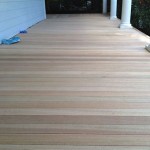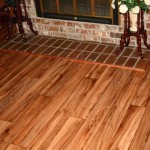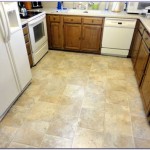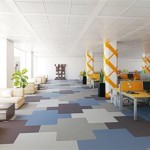Black and White Checkerboard Linoleum Flooring: A Timeless Classic
Black and white checkerboard linoleum flooring represents a design choice steeped in history, versatility, and enduring appeal. From its humble origins to its contemporary resurgence, this flooring pattern has consistently proven its ability to adapt to diverse architectural styles and aesthetic preferences. This article aims to provide a comprehensive overview of black and white checkerboard linoleum flooring, encompassing its history, advantages, installation considerations, maintenance requirements, and stylistic applications.
The inherent visual impact of a black and white checkerboard pattern stems from its stark contrast and geometric precision. This contrast creates a dynamic interplay of light and shadow, lending visual interest and a sense of spaciousness to any room. The pattern inherently possesses a retro charm, often evoking associations with mid-century modern design, diners, and a classic, timeless aesthetic. However, its adaptability extends far beyond these specific styles, allowing it to be successfully incorporated into contemporary, minimalist, and even eclectic design schemes.
Linoleum itself is a natural and sustainable flooring material, composed primarily of linseed oil, rosin, wood flour, cork dust, and pigments. This composition contributes to its durability, resilience, and anti-static properties. Unlike vinyl flooring, which is often petroleum-based, linoleum is a more environmentally friendly choice. The manufacturing process also generally involves less energy consumption compared to synthetic alternatives.
Historical Significance and Evolution
The history of checkerboard flooring patterns can be traced back centuries, appearing in various forms in ancient Roman mosaics and Renaissance-era architecture. However, the widespread adoption of black and white checkerboard flooring, particularly in linoleum, gained momentum in the late 19th and early 20th centuries. As linoleum became a more affordable and accessible flooring option, its application expanded from institutional settings to residential spaces. The checkerboard pattern offered a visually appealing and easily customizable design solution, allowing homeowners to personalize their interiors.
During the mid-20th century, black and white checkerboard linoleum flooring experienced a surge in popularity, becoming a defining feature of the diner aesthetic and associated with a sense of nostalgia and Americana. This association cemented its place in popular culture and contributed to its enduring appeal. While design trends have evolved over time, the checkerboard pattern has consistently remained a viable option, demonstrating its ability to transcend fleeting fads. Modern interpretations often incorporate variations in tile size, color combinations (though black and white remains the most iconic), and material textures, further expanding its versatility.
The resurgence of interest in vintage and retro design has further fueled the popularity of black and white checkerboard linoleum flooring in recent years. Homeowners seeking to create a classic or nostalgic atmosphere often gravitate towards this pattern, appreciating its historical significance and timeless appeal. The availability of high-quality linoleum products, coupled with improved installation techniques, has made it easier than ever to incorporate this design element into contemporary homes.
Advantages of Black and White Checkerboard Linoleum
Beyond its aesthetic appeal, black and white checkerboard linoleum flooring offers a range of practical advantages that contribute to its enduring popularity. These benefits extend from its durability and ease of maintenance to its environmental friendliness and versatility in design applications.
Durability is a key characteristic of linoleum flooring. When properly installed and maintained, it can withstand heavy foot traffic and resist wear and tear for many years. The natural composition of linoleum contributes to its resilience, allowing it to recover from minor dents and scratches. The color is also ingrained throughout the material, meaning that any surface damage is less noticeable compared to flooring options with a printed surface layer. This inherent durability makes it a suitable choice for high-traffic areas such as kitchens, bathrooms, and entryways.
Ease of maintenance is another significant advantage. Linoleum is relatively easy to clean and maintain, requiring only regular sweeping and occasional damp mopping. The anti-static properties of linoleum also help to repel dust and dirt, reducing the frequency of cleaning needs. The smooth, non-porous surface of linoleum resists staining and the growth of mold and mildew, making it a hygienic flooring option for homes with children or pets. For deeper cleaning, a mild detergent can be used, but harsh chemicals should be avoided to prevent damage to the surface.
The environmental friendliness of linoleum is a compelling factor for environmentally conscious consumers. As a natural and sustainable material, linoleum is made from renewable resources and does not emit harmful volatile organic compounds (VOCs). This makes it a healthier choice for indoor air quality, particularly for individuals with allergies or sensitivities. The production process also generally involves less energy consumption and waste compared to synthetic flooring options. The longevity of linoleum flooring further contributes to its sustainability, reducing the need for frequent replacement and minimizing waste disposal.
Finally, the stylistic versatility of black and white checkerboard linoleum flooring cannot be overstated. While often associated with retro and mid-century modern design, it can be successfully integrated into a wide range of architectural styles and aesthetic preferences. It can complement minimalist interiors by adding a touch of visual interest, or it can enhance the charm of traditional spaces. The contrast between black and white creates a sense of dynamism and depth, making it a visually appealing choice for any room. The pattern can also be customized by varying the tile size, border designs, and accent colors to create a unique and personalized look.
Installation and Maintenance Considerations
Proper installation is crucial for maximizing the lifespan and performance of black and white checkerboard linoleum flooring. While DIY installation is possible, professional installation is generally recommended, particularly for complex patterns or larger areas. A skilled installer will ensure that the subfloor is properly prepared, the tiles are accurately aligned, and the seams are tightly sealed. This will prevent moisture penetration, reduce the risk of tile movement, and ensure a smooth and even surface.
Subfloor preparation is a critical step in the installation process. The subfloor must be clean, level, and dry before linoleum tiles can be installed. Any imperfections in the subfloor, such as cracks or unevenness, should be repaired to prevent problems with the finished floor. A self-leveling compound may be necessary to create a perfectly smooth surface. In some cases, an underlayment may be recommended to provide additional cushioning and sound insulation.
The installation process typically involves adhering the linoleum tiles to the subfloor with a specialized adhesive. The adhesive should be specifically designed for linoleum flooring and applied evenly to ensure a strong and durable bond. The tiles should be carefully aligned to create a uniform checkerboard pattern. Spacers can be used to maintain consistent gaps between the tiles. Once the adhesive has dried, the seams should be sealed with a sealant to prevent moisture penetration and dirt accumulation.
Regular maintenance is essential for preserving the appearance and longevity of black and white checkerboard linoleum flooring. Routine sweeping or vacuuming will remove loose dirt and debris, preventing scratches and maintaining the surface's shine. Damp mopping with a mild detergent is recommended for deeper cleaning. Harsh chemicals, abrasive cleaners, and scouring pads should be avoided, as they can damage the surface of the linoleum. A neutral pH cleaner is typically the best option.
Protecting the flooring from scratches and dents is also important. Furniture legs should be equipped with felt pads to prevent damage from movement. Heavy objects should be placed on protective mats or rugs. Avoid dragging heavy items across the floor. Regularly inspect the flooring for any signs of wear or damage and address them promptly. Minor scratches can sometimes be repaired with a specialized linoleum repair kit.
Over time, linoleum flooring may develop a dull or faded appearance. To restore its original shine, a specialized linoleum polish or wax can be applied. Follow the manufacturer's instructions carefully and test the product in an inconspicuous area first to ensure compatibility. Regular polishing will help to protect the surface of the linoleum and maintain its vibrant color.
Applications in Interior Design
Black and white checkerboard linoleum flooring offers a versatile design element that can be incorporated into a wide range of interior design styles. Its inherent visual impact and classic appeal make it a suitable choice for various rooms and applications.
In kitchens, black and white checkerboard linoleum flooring can create a retro-inspired atmosphere or add a touch of visual interest to a modern design. It complements both light and dark cabinetry and provides a durable and easy-to-clean surface for a high-traffic area. Pair it with stainless steel appliances and vintage-inspired accessories for a classic diner look, or combine it with sleek, minimalist cabinets for a contemporary twist.
Bathrooms can benefit from the clean and classic look of black and white checkerboard linoleum flooring. Its moisture resistance and easy maintenance make it a practical choice for this space. Use it to create a vintage-inspired bathroom with clawfoot tubs and pedestal sinks, or incorporate it into a modern bathroom with clean lines and minimalist fixtures.
Entryways and hallways can benefit from the durability and visual impact of black and white checkerboard linoleum flooring. It creates a welcoming entrance and provides a durable surface for high-traffic areas. Use it to add a touch of personality to a narrow hallway or to define the entryway of a home.
Beyond these specific rooms, black and white checkerboard linoleum flooring can also be used in other areas of the home, such as laundry rooms, playrooms, and home offices. Its versatility and durability make it a suitable choice for any space where a stylish and easy-to-maintain flooring option is desired.
The scale of the checkerboard pattern can also influence the overall look and feel of a room. Larger tiles create a more modern and expansive feel, while smaller tiles evoke a more traditional and intricate look. Consider the size of the room and the desired aesthetic when selecting the tile size.
Finally, consider incorporating accent colors and patterns to complement the black and white checkerboard linoleum flooring. Bold colors, such as red, yellow, or blue, can add a pop of personality to the space. Geometric patterns, such as stripes or floral motifs, can also be used to create a visually interesting and cohesive design.

Checkerboard Vinyl Black White Factory Direct Flooring

2 Places To Buy Black And White Checkerboard Floor Tile In Resilient Vinyl Sheet Retro Renovation Linoleum Flooring

Squares Stove Black Heritage Colours By Harvey Maria

Checkerboard Sheet Vinyl Flooring Lino In Black And White Marble Tile Pattern

Checkerboard Vinyl Black White Factory Direct Flooring

Achim Sterling Black And White Checd 12 In X L Stick Vinyl Tile 20 Sq Ft Case Stt1m10320 The Home Depot

Marmoleum Floors Gallery Slaughterbeck Inc Campbell Ca

Checkerboard Sheet Vinyl Flooring Lino In Black And White Marble Tile Pattern

Black White Checd Vinyl Floor Tiles Adhesive Stick And L 12 X 1 Pack 20 Pieces Com

2 Places To Buy Black And White Checkerboard Floor Tile In Resilient Vinyl Sheet Retro Renovation Flooring Kitchen








